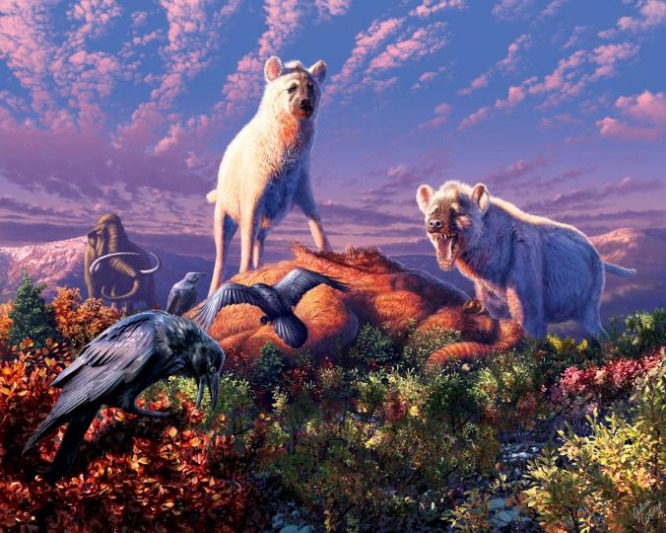
Discovered on the banks of the Old Crow River in the 1970s, the newly described fossils are the most northerly evidence for hyenas yet found, researchers report today in the journal Open Quaternary. Until now, the northernmost hyena fossils in North America came from Kansas, about 2,500 miles south of the Yukon Territory finds.
The newfound fossils belong to animals in the extinct genus Chasmaporthetes, which lived between 800,000 and 1.4 million years ago. During this time, conditions in the Arctic may have been even harsher than they are today, with near permanent snow and ice throughout the year.
"These new fossils add to [the] geographical and biological range that hyenas could have," says lead author Jack Tseng, a paleontologist at the University at Buffalo in New York. The discovery also adds to evidence that ancient hyenas made it from their evolutionary home in Eurasia to North America via the Bering land bridge, crossing this northern span despite the frigid conditions.
"We have proof that hyenas were up there, and at least they are capable of being found there. Maybe they travelled through and died, but they were going through that area," Tseng says.
Shaggy predator
The four hyena species alive today are mostly restricted to Africa and are adapted to lower elevation savannas and relatively warmer, drier environments. But paleontologists know of about 70 species of prehistoric hyenas found all across the Northern Hemisphere.
Comment: And so isn't it more likely that, rather than this being some kind of 'arctic' hyena, it was the climate that was different?
"If you only look at living species, you are examining less than 10 percent of hyena diversity," Tseng says.
Chasmaporthetes had long legs compared to modern hyenas and was likely a faster runner and a better pursuit predator, Tseng says. As well as scavenging carcasses and cracking through bones with its powerful teeth and jaws, the animal may have hunted Arctic animals, including caribou, horses, and maybe even mammoth.
"We are not saying they were hunting down adult mammoth-that would be a feat for any carnivore," Tseng says. "But young and even juvenile [African] elephants are within the ability of spotted hyenas to take down. I see that as a good analogue to interpret how Chasmaporthetes would have hunted."
The team also thinks it's possible these Arctic hyenas had dense fur similar to that on mammoths or woolly rhinos, and that the hyenas might have undergone changes in coat color with the seasons, akin to what's seen today in Arctic hares and foxes.
Comment: There's good reason we don't see rhinos nor elephants in the arctic nowadays, because the climate is too harsh and there's simply not enough food sources for them to survive.
"It's not that far-fetched to imagine these Arctic hyenas were shaggy and even had these coat changes, with a paler coat in winter, so they can be successful at hunting in the snow," Tseng says.
Hyena migration
While hyenas evolved in Eurasia, Chasmaporthetes is part of a lineage that made it into North America about five million years ago and spread all the way down to Mexico. These hyenas are though to have survived until around a million years ago, making the new fossil teeth some of the youngest known fossil evidence for hyenas in North America.
Researchers have long assumed hyenas must have passed into North America via the Bering land bridge between Siberia and Alaska, when sea levels were lower, but this is the first hard evidence that hyenas could survive well enough in Arctic environments to make that journey.
"It's really fun and exciting to see that hyenas were in fact in the Arctic and that they did take this migration route," says Larisa DeSantis, an expert on fossil carnivores at Vanderbilt University who was not involved in the research. "It confirms what people had long thought ... that these hyenas had come through Beringia and the land bridge to make it into more southern regions of North America."
"We're finding Pleistocene carnivores farther north than they've ever been found before," adds Ashley Reynolds, a paleontologist at the University of Toronto who recently documented the first evidence for the saber-tooth cat Smilodon in Canada.
"Carnivores are very important parts of an ecosystem," she says, "but they're often rare in the fossil record, so every new find is important."



Comment: As Pierre Lescaudron writes in Of Flash Frozen Mammoths and Cosmic Catastrophes: See also: